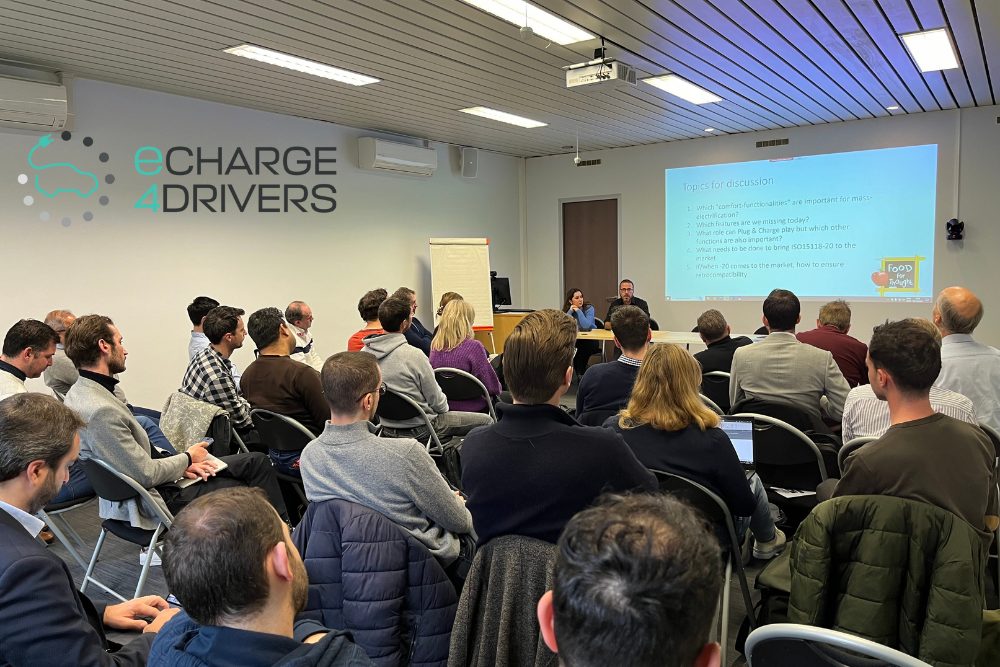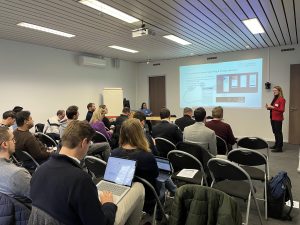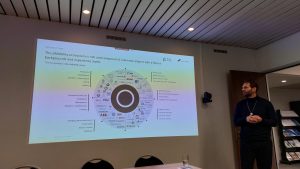On 6 December 2023, the eCharge4Drivers project organised a successful workshop on ISO15118 Plug&Charge functionalities. This was an exceptional opportunity for participants to immerse themselves in the intricacies of ISO15118 Plug&Charge technology. Throughout the event, project partners, along with the external stakeholders, explored the nuances of the project’s strategy but also delved into the challenges and milestones encountered along the way. Overall, the event provided a unique platform for attendees to gain deeper insights into eCharge4Drivers’s work, exchange innovative ideas, and collectively contribute to making a meaningful impact in the Plug&Charge technology ecosystem, including recommendations and future developments.
 The meeting started with the welcome words and introduction to eCharge4Drivers from host POLIS and ICCS, project coordinator, who briefly explained the project concept, the innovations being tested, and the role of the external stakeholders as communities of practice and support for project dissemination and exploitation. It then followed with a presentation from the European Commission on the latest AFIR developments and the upcoming Delegated Act on standards and EU PKI for e-mobility, including architecture and governance.
The meeting started with the welcome words and introduction to eCharge4Drivers from host POLIS and ICCS, project coordinator, who briefly explained the project concept, the innovations being tested, and the role of the external stakeholders as communities of practice and support for project dissemination and exploitation. It then followed with a presentation from the European Commission on the latest AFIR developments and the upcoming Delegated Act on standards and EU PKI for e-mobility, including architecture and governance.
Hubject provided a detailed presentation on ISO15118 Plug&Charge, the market ecosystem and current status in Europe, and the evolving standards, as well as other aspects such as multi-contract handling. This was the opportunity to ensure that all participants were fully aware of what this technology is, and what are its main benefits and challenges.
Afterwards, it was time to bring eCharge4Drivers into the spotlight – the different project partners to present the main achievements, challenges and lessons learned, from the point of view of car OEMs (Volvo and BMW), charge point operators and e-mobility service providers (Route220 and IDIADA), and charge point manufacturers (ABB).
Plug&Charge is a game changer – but are we there yet?
Plug&Charge technology, although one important step towards a user-friendly EV charging experience, is complex and involves many actors from the e-mobility ecosystem – car OEMs, CPOs, eMSPs, charge point manufacturers, and e-roaming platforms, among others. eCharge4Drivers project started by addressing the specific challenge of improving the EV driver experience, but during the project duration the market has developed quite fast, and so did the challenges to address (from V1G to V2G, for example). Therefore, e-mobility actors involved in Plug&Charge need to be adaptable and trust each other– a bit like in a long-term “marriage”.
Regulations at the European Commission level are also evolving, and need to reflect the e-mobility transition. This starts with changes in the vehicle type approval process, as it is designed for ICE vehicles and not currently fit for EVs (in such issues as data, for example). We also need to ensure that the current Fit for 55 Regulations is fully aligned and coherent, which is not the case. Moreover, the obligations on data provision settled by AFIR regulation, and under the revised Renewable Energy Directive are quite demanding, but the implementation at the national level is up to Member States discretion. So, there is room for “mismatched puzzles” when it comes to Plug&Charge implementation throughout Europe.
A fragmented ecosystem
The multitude of stakeholders involved in the e-mobility transition is a key enabler for innovation, but also a challenge that needs to be successfully addressed from a policy and regulatory perspective.
As it stands, despite the potential of Plug&Charge technology, the different actors are currently struggling to deploy the ISO15118PnC and offer it as a service to their customers. During the event, it was also highlighted that the national and local public authorities are lagging in this regard. There are still various issues with payment terminals, which significantly hampers the EV driver experience. Plug&Charge could be a step into addressing these issues.
Project partners highlighted that the next challenge in the successful deployment of this innovation is the adoption by commercial fleets, including heavy-duty trucks. Due to the transnational nature of long-haul freight, Plug&Charge technology can be a solution to ensure a seamless charging experience. But if there is a mandate for charging points to allow for both Plug&Charge and complementary means of payment, like a credit card reader and a pin pad terminal payment, will this result in excessive costs for charge point manufacturers and CPOs, especially if there is the need to refurbish many charge points? And most importantly, can we ensure the buy-in of truck OEMs, as the vehicles need to be ready for this technology? The answer may be yes, as truck OEMs don’t want to lose customers and will be open to these innovations if there is demand for it.
There are also market fairness issues when it comes to e-roaming: currently, a new CPO that wants to operate in different countries Europe needs to register in the whole EU, and not only in the countries it wishes to operate. This is particularly challenging for small and medium-sized companies, who struggle to deal with complex administrative procedures.
Transitioning from ISO15118-2 to ISO15118-20 standards
During the event, participants enquired about the transition from the Plug&Charge standard ISO15118-2, which is currently in use by the project, to the new ISO15118-20 standard, which is favored by the European Commission and allows for other functionalities like V2G. The simple answer is, that the former is a “trialed and tested” protocol that ensures cyber security and data privacy, as well as convenience. And often, the door to future developments. It is an enabler for -20 but lacks some of its functionalities. There is also reluctance from car OEMs: no one wants the risks of being the early bird when it comes to ISO15118-20 widespread deployment. And without mandatory requirements from the part of the European Commission, this process will take some time. For the short-medium term, we will need both standards being implemented in parallel. This “side by side” approach is inevitable for the next 10 years, as the market matures.
Challenges ahead
When it comes to user-friendly charging experience, who has the better approach? The USA opted for an open approach where charging points can offer one of three options:
- Autocharge,
- Payment card readers/pin pad terminals,
- Plug& Charge.
But is this an advantage or a disadvantage for consumers? Like the adoption of USB Type C chargers, the EU is pushing for a universal solution to increase user-friendliness and convenience, but also considering that Plug&Charge ensures privacy and cybersecurity to the user.
During the discussion, some of the attending stakeholders stated that while Plug&Charge can be a nice feature, it should not be considered an essential aspect of the process. Enabling V2G could be seen as much more useful for EV drivers. Plug&Charge still comes with privacy issues that may prevent it from becoming a fully widespread solution. To ensure user-friendly and convenient EV charging experience, policymakers and market actors should pay special attention to cyberattacks and cybersecurity, as they are key to make (or break!) this technological innovation.




